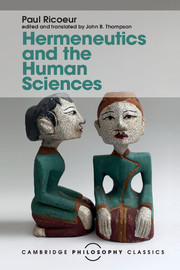Book contents
- Frontmatter
- Contents
- Preface to this edition
- Acknowledgements
- Editor's introduction
- Notes on editing and translating
- A response by Paul Ricoeur
- Part I Studies in the history of hermeneutics
- Part II Studies in the theory of interpretation
- Part III Studies in the philosophy of social science
- Select bibliography
- Index
Preface to this edition
Published online by Cambridge University Press: 05 July 2016
- Frontmatter
- Contents
- Preface to this edition
- Acknowledgements
- Editor's introduction
- Notes on editing and translating
- A response by Paul Ricoeur
- Part I Studies in the history of hermeneutics
- Part II Studies in the theory of interpretation
- Part III Studies in the philosophy of social science
- Select bibliography
- Index
Summary
The move of the term ‘hermeneutics’ from its original home in textual (at first Biblical) interpretation to its new application to history and human science owes a great deal to two outstanding twentieth-century philosophers, Hans-Georg Gadamer and Paul Ricoeur.
The move can be understood in the light of two crucial insights. The first is that ‘understanding’ can have a quite different sense applied to human affairs from that which it has in natural science or technology. Understanding why you made that surprising move involves something rather different from understanding why my car broke down. Thus we often say things like (1) ‘I can't understand him. He seems to be sabotaging, undermining his most cherished goal’; or (2) ‘That reaction seems totally over the top, uncalled for’; or (3) ‘He seems to be deliberately provoking opposition’; or (4) ‘Why did she put her demand in those terms, which almost guaranteed refusal?’ In all these cases, the actor is (provisionally) opaque to us; we cannot understand him or her.
We explain properly, we make sense of the action/response, when we add to or complexify the range of meanings or motivations actually operating here. It was Dilthey who made this point most forcefully, and he influenced some important twentieth-century sociologists, like Max Weber.
The second point is that there are important features in common between making sense of human beings and understanding texts. In particular, a certain kind of circularity attaches to both types of account. The aim, in the original context of Bible interpretation, was often to clarify a particular passage which was uncertain or enigmatic. But the reading offered of this passage or verse had to make sense within the presumed overall meaning of the entire chapter, book, and ultimately, of the whole Bible. One could thus use the sense of the whole to make sense of the part. But a question can always be raised: do we understand fully the meaning of the whole?
There is a circle here, but not a vicious one. It doesn't involve the notorious ‘circular argument’, where one assumes the conclusion among the premises. On the contrary, the attempt is to bring the arguments in both directions into an equilibrium in which one makes maximum sense of the text. But a similar circularity applies to making sense of action.
- Type
- Chapter
- Information
- Hermeneutics and the Human SciencesEssays on Language, Action and Interpretation, pp. vii - viiiPublisher: Cambridge University PressPrint publication year: 2016

